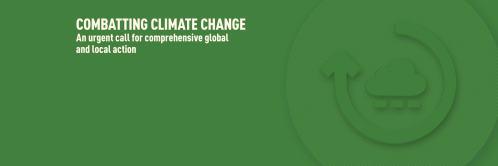Prior to the COVID-19 pandemic, extreme poverty had been steadily declining worldwide for more than two decades. Now, due to the health and economic effects of the pandemic, the world faces a severe setback to this progress. Pandemic-related shocks to lives and livelihoods are hitting the already poor and vulnerable hard, as well as pushing millions of new people into poverty. Furthermore, the COVID-19 crisis is exacerbating—and being exacerbated by—the ongoing impacts of climate change and armed conflict. The World Bank examines these concerning trends in its annual report, “Poverty and Shared Prosperity 2020: Reversals of Fortunate,” published in early October.
The report argues that, even after the COVID-19 pandemic is controlled, climate change will continue to pose a critical threat to poverty reduction, potentially driving about 100 million additional people into poverty by 2030. The effects of climate change are projected to be particularly acute in sub-Saharan Africa and South Asia, where most of the global poor currently live, because those living in poverty or near poverty are particularly vulnerable to climate-related natural disasters due to greater reliance on low-quality infrastructure, dependence on income from agriculture, and ownership of lower-quality and thus easily damaged assets, among other factors. In addition to being more vulnerable, poor people are often more exposed to natural disasters: For example, in urban areas in West and Southern Africa, there is a strong positive relationship between levels of poverty and exposure to flooding.
Floods are one of the most common and severe natural disasters induced by climate change, especially in low-income countries where infrastructure systems to manage floods tend to be weaker. Figure 1 shows the subnational relationship between poverty levels and flood risk in sub-Saharan Africa; areas colored in dark blue both face a high risk of flooding and have high levels of poverty. This map shows that there is not an exact overlap between flood risk and poverty: There are areas of Ethiopia, Gabon, and Guinea, for example, where poverty rates are relatively low but there are high levels of exposure to flood risk. However, many subnational areas in Central and West Africa, as well as in Madagascar and Mozambique, face both high levels of poverty and high exposure to flood risks associated with climate change.
Figure 1. Joint distribution of poverty and flood risk in sub-Saharan Africa
 Sources: World Bank, Poverty and Shared Prosperity 2020: Reversals of Fortune. Estimates based on data from the Global Subnational Atlas of Poverty, Global Monitoring Database, and Rentschler and Salhab 2020.
Sources: World Bank, Poverty and Shared Prosperity 2020: Reversals of Fortune. Estimates based on data from the Global Subnational Atlas of Poverty, Global Monitoring Database, and Rentschler and Salhab 2020.
Note: Scale thresholds for poverty and climate risk are based on terciles. Both axes represent the percentage of the population. Those who live with a flood risk face inundation depths of over 0.15 meters in the event of a 1-to-100-year flood. Those in poverty live below the $1.90 per day poverty line.
The report notes that, while floods are a common and severe type of climate risk, they are by no means the only type of climate risk. Sub-Saharan Africa will also face substantial challenges from climate-induced increases in the frequency and severity of droughts, high temperatures, and other natural disasters such as cyclones. These risks can compound each other: For instance, in Central Africa, populations may face both floods and extremely high temperatures that can pose severe health risks. Thus, the report states that the analysis of flood risk represents a lower bound of the magnitude of challenges that countries may face from exposure to climate risks. Overall, the poor in sub-Saharan Africa face greater exposure and vulnerability to climate risks—including not just flooding, but droughts and higher temperatures—than the poor in other world regions.
For more on the potential impact of climate change and flooding in Africa, see “Confronting the challenges of climate change on Africa’s coastal areas” by Ahmadou Aly Mbaye. For more on how Africa can fight climate change, see “Africa can play a leading role in the fight against climate change” by Ngozi Okonjo-Iweala.
The Brookings Institution is committed to quality, independence, and impact.
We are supported by a diverse array of funders. In line with our values and policies, each Brookings publication represents the sole views of its author(s).






Commentary
Figure of the week: Flood risk and poverty in sub-Saharan Africa
October 29, 2020